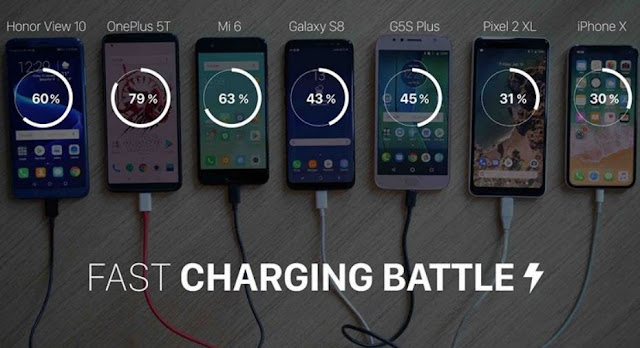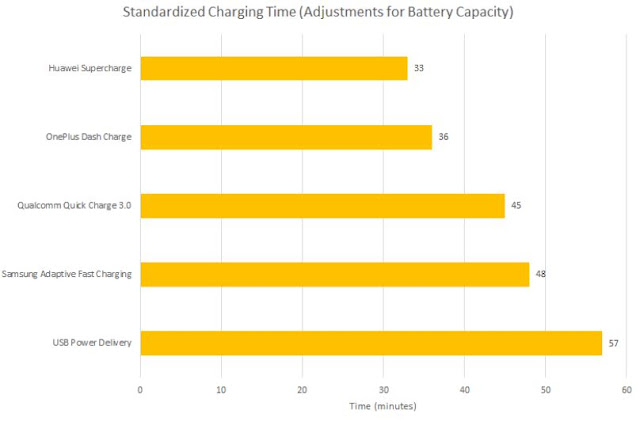While purchasing a smartphone everyone takes into consideration its Processor, RAM and screen sizes. But as the hunger of speed increased, so the battery sizes of the phones. Therefore it become essential to charge the phone fast so as to fill up whole battery in little time and now it’s the biggest selling point while purchasing smartphones.
Each smartphone company has developed its own fast charging technology whether it be Samsung’s Adaptive Fast charging, Qualcomms Quick charge or OnePlus Dash Charge. But how does fast charging work, let’s find out.
HOW FAST CHARGING WORKS
First of all let us understand how battery charges and works. Every battery works in the same concept having two electrodes and an electrolyte catalyze reactions that convert compounds into new substances. Ions and atoms with too few or too many electrons form in the electrodes, driving a flow of electrons to the battery’s negative outer terminal and thereby supplying your phone with an electric charge.
In non-rechargeable batteries, these chemical reactions occur only once. But in the rechargeable lithium-ion or lithium polymer batteries that power smartphones, the reactions are “reversible.” When the battery discharges, the chemical reaction produces electricity, and when the battery recharges, the chemical reactions absorb power.
Fast charging
Before we understand how fast charging works, we need to know about charge controller.
Batteries charge when a current passes through them so greater is the current coupled with higher voltage, charge batteries faster, but there’s a limit to what they can take. So for this situation charge controller (IC) is used to protect against dangerous spikes in current.
The controller chip regulates the overall flow of current in and out of the battery and it is generally controlled by phones software
USB charging standards
Although we have wireless charging still 90% of the phones are still charged by USB cable because they are robust and easy to find.
Although we have wireless charging still 90% of the phones are still charged by USB cable because they are robust and easy to find.
USB 1.0 and 2.0 ports can deliver current up to 5V/0.5A (2.5W). This is the charging rate of ordinary phone. USB 3.0 ports push 5V/0.9A (4.5W).
Meanwhile the USB-C, the oval-shaped reversible plug on newer smartphones, is a unique connecter. It’s can carry USB 2.0 and USB 3.1 as well therefore it is able to carry more charge.
FAST CHARGING STANDARDS: WHAT’S THE DIFFERENCE?
Apple fast charging:
Pros
- It uses industry standard known as USB-PD,
- It does not require any special cables.
Cons
- Apple does not include USB-PD-compatible chargers in the box. So you will have to buy one separately.
From iPhone 8 apple has implemented USB-PD. It is the same industry standard used by the iPad Pro, the 12-inch MacBook, Google’s Chrome book Pixel, and Lenovo’s X1 Carbon.
Charging speed
IPhones have hard-coded safety limits predefined, so it does not matter on your choice of cables. When your battery capacity is between 0 and 79 percent fast charging kicks in, but stops when it reaches 80 percent.
Qualcomm Quick Charge
Voltage
|
Current
|
Max Power
|
|
Quick Charge 1.0
|
5V
|
2A
|
10W
|
Quick Charge 2.0
|
5V/9V/12V
|
1.67A/2A
|
18W
|
Quick Charge 3.0
|
3.6V – 20V (200mV increments)
|
2.5A/4.6A
|
18W
|
Quick Charge 4.0
|
N/A
|
N/A
|
N/A
|
Quick Charge 4.0+
|
5V/9V (USB-PD), 3.6V – 20V (200mV
increments)
|
3A (USB-PD), 2.5A/4.6A
|
27W (USB-PD)
|
Pros
- Widely implemented and used charging standard.
- Latest version compatible with older ones as as well.
- Built-in safety features prevent overheating and short circuiting.
Cons
- Quick Charge 3.0 isn’t USB-PD compliant.
This is one of the most widely used standard. It is an optional feature of Qualcomm system-on-chip technology like the Snapdragon 845, 835, 820, 620, 618, 617, and 430, which power thousands of phones. Also any smartphone manufacturer is free to license Quick Charge’s power controller technology therefore it’s not tied to Qualcomms chipsets.
Tech specs and compatible adapters
Quick Charge uses traditional approach by upping the charging voltage, which in turn boosts the wattage. There latest iteration Quick Charge 4.0 is used in very few devices. Also they have algorithms called Intelligent Negotiation for Optimum Voltage (INOV) which identifies the most efficient voltage at any giving point during charging.
Charging speed
Qualcomm claims Quick Charge 4+ can recharge smartphones to 50 percent in just 15 minutes.
Safety measures
Quick Charge uses intelligent thermal balancing which senses the coolest path to deliver the current and thereby preventing overheating and short-circuiting.
Samsung Adaptive Fast Charging
Voltage
|
Current
|
Max Power
|
|
Samsung Adaptive Fast Charging
|
5V/9V
|
2A
|
18W
|
Pros
- Available in all latest Samsung devices.
- Compatible with Qualcomm Quick Charge 2.0.
Cons
- Becomes conservative some times.
This charging technology is exclusive to Samsung devices such as Galaxy S8, S9 and Note 9. It is fully compatible with Exynos SOC found in international versions of Samsung devices as well.
Tech specs and compatible adapters
Theoretically Samsung adaptive fast charging has peak output of 9V/2A (18W), but in reality it becomes aggressive and you will need to buy certified charger with compatible accessories.
Charging speed
Samsung is hesitant when it comes to publishing charging times for Adaptive Fast Charging. During our testing with Galaxy S8 it took two hours to fully charge the 3000mAh battery. This is almost similar to other devices with quick charge technology.
Safety measures
Samsung is more conservative while charging the battery and this enhance the safety of the user. While charging the device maintains coolest temperatures which other manufacturers does not do.
Motorola TurboPower
Voltage
|
Current
|
Max Power
|
|
TurboPower 15
|
9V/12V
|
1.2A/1.67A
|
15W
|
TurboPower 25
|
5V/9V/12V
|
2.15A/2.85A
|
25W
|
TurboPower 30
|
5V
|
5.7A
|
28.5W
|
Pros
- Built into all Motorola devices.
- Compatible with Quick Charge 2.0.
Cons
- Not as fast as compared to other charging standards.
In short Motorala’s Turbo-power standard is just a tweaked version of Quick Charge 2.0
Tech specs and compatible adapters:
TurboPower adapters have three versions: TurboPower 15, TurboPower 25, and TurboPower 30. The fastest one is TurboPower 3 which delivers 5V, 5.7A and 28.5W of power.
Plus point of Motorola’s turbo charger is that Motorola works with manufacturers to design custom batteries along with is power management software’s which monitor battery status and adjust charge accordingly. Also you do not need to buy additional charger, just buy any Quickcharge 2.0 compatible charger and you are good to go.
Charging speed:
Motorola’s TurboPower 30 can deliver up to 15 hours of battery life in just 15 minutes.
Safety measures:
TurboPower has Thermal management hardware which avoids charging slowdowns due to heat, therefore maintaining a steady and fast charging rate.
MediaTek Pump Express:
Voltage
|
Current
|
Max Power
|
|
MediaTek Pump Express 2.0+
|
5V – 20V (0.5V increments)
|
3A/4.5A+
|
15W
|
MediaTek Pump Express 3.0
|
3V – 6V (10-20mV increments)
|
5A+
|
25W/30W
|
Pros
- Built-in safety measures prevent short circuiting and overheating.
- Compatible with Quick Charge 2.0.
Cons
- Potentially slower than other available options.
Like other manufacturer’s MediaTek has its own charging standard known as Pump Express. Pump Express 2.0+ and Pump Express 3.0, are two different variant’s targeting low end and high end devices.
Tech specs and compatible adapters
Pump Express + 2.0 charges between 5V and 20V and Pump Express 3.0’s 3V – 6V. Pump Express 3.0’s has three charging stages — Regular, Turbo 1, and Turbo 2 — the fastest of which only supports 15W (1.67A).
Charging speed
Pump Express 3.0 can charge battery up to 75 percent in 20 minutes, whereas its sibling Pump Express 2.0+ take about 30 minutes to reach the same capacity.
Safety measures
Pump Express is most safe charging technology available in the market and has more than 20 safety mechanisms to prevent short-circuiting.
OnePlus Dash Charge and Oppo Vooc
Voltage
|
Current
|
Max Power
|
|
Dash Charge
|
5V
|
4A
|
20W
|
Oppo Vooc
|
5V
|
5A
|
25W
|
Pros
- Keeps phones cooler.
- One of the fastest charging standards.
- Adapters included with compatible smartphones.
Cons
- Highly proprietary.
Oppo’s VOOC (Voltage Open Multi-Step Constant-Current Charging) system is headline feature in their devices such as Find X. This technology is available in another name in OnePlus devices called Dash Charge.
Tech specs and compatible adapters
Dash Charge operates at a peak of 5V/4A (20W) and its Lamborghini edition operates at 30W. Whereas Oppo’s latest Super VOOC works at 50W thereby giving 2 hour’s talk-time in just 5 min charge. This is achieved by bumping the charger’s amperage instead of the voltage, with this they are able to achieve more even distribution of electrical current at higher levels. A microcontroller monitors charge level of the device and regulates voltage and current. All this is not possible without custom-designed cable which delivers greater current while minimizing power fluctuations.
Catch here is that you need compatible charges, cables for enjoying the benefit of Dash Charge or VOOC charge.
Charging speed
OnePlus Dash Charge charges 60 percent battery in 30 minutes. Whereas Oppo Super VOOC clams charge to 80 percent in 30 minutes.
Safety measures
Both charging techniques are designed to dissipate heat quickly. Because the charger steps down the high voltage from the adapters power source into a lower voltage so most of the heat from the conversion never reaches the phone. Also the device have heat management and dissipation hardware that undergo a thorough five-point safety check.
Huawei SuperCharge
Voltage
|
Current
|
Max Power
|
|
Huawei SuperCharge
|
4.5V/5V
|
4.5A/5A
|
25W
|
Pros
- Compatibility with USB-PD.
- Thorough safety measures.
- Adapters included with compatible smartphones.
Cons
- Potentially slower than some standards.
SuperCharge which is Huawei’s charging standard, is built into phones like the Huawei Mate 20 Pro, Mate 9 and the Huawei P10. It’s resembles Quick Charge in way that it uses higher-than-average voltages to achieve faster charging.
Tech specs and compatible adapters
SuperCharge automatically adapts the incoming voltage and charges according to condition of the phone’s battery and phone’s internal temperature. The maximum SuperCharge charging voltage is 5V/4.5A (up to 22.5W)
Similar to Oppo and OnePlus, Huawei’s SuperCharge technology also requires buying a compatible wall adapter.
Charging speed
SuperCharge charges device to max in around an hour and ten minutes.
Safety measures
Huawei’s Smart Charge technology identifies the load capacity of the charger and cable and reduces the voltage to match. Also it has 8 layer cooling system and special lining that keeps devices up to 5-degrees Celsius cooler than other fast-charging standards.
THE FUTURE OF FAST CHARGING
Fast charging technology is gaining hype these days. With advancements in hardware technology and much more cooling system we could see much faster charging standards in near future.






Comments
Post a Comment